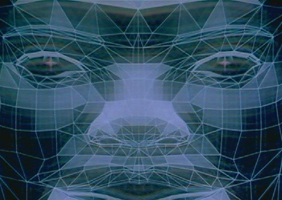
I don’t think there will be a gaming roundup today, because all the "news" that piled up over the weekend consists of Joystiq whining about aesthetics of game purchases, fanboys complaining about the lack of console exclusivity of Capcom games, and something about a "teaser teaser" for Grand Theft Auto IV. Come on, people; if there’s no news, don’t force it.
Instead, today I’m going to put down a few paragraphs about a topic that’s near and dear to me, and hateful to the army of people who think I’m pretentious: It’s the "games as art" debate! I dearly love this hobby of fucking with electrons and, though I think classification of games as "art" is implicitly pointless, I have often wanted to respond to the critical limitations denying them such status imposes.
I don’t know how many times I’ve heard art professors and students, as well as tour guides in museums, declare that art is meant to form a sense of interaction with the viewer. Modern artists and pop artists create entirely on the supposition that their audience will feel some kind of emotional interaction, which then colors their perception of the piece. Artists create art in the hope that an audience will feel enough of an emotional interaction to form a bond with the creation. It’s a low level of interaction, a kind of call-and-response, but it fits the definition of the word.
That establishes that interaction does not invalidate art. Videogames represent the current peak of capable interaction between an audience and a created work. In fact, such interaction is their goal, which would seem to suggest that game designers are more capable of manipulating that particular set of neurons in an audience than artists are.
The problem that follows is that art tends to have an intent, and the artist exercises a control over the piece, while videogames request the player to exercise the control. As Roger Ebert famously put it, there is too small a portion of authorial control in videogames to qualify them as art. As he was speaking as a film critic, I believe Ebert’s opinion is rather narrow; he suggests that the significant form of control exercised in artistic film is a linear control, narrative and visual. What his opinion, and the argument that he has come to symbolize, fails to consider is that game designers exercise an even greater control over their products than filmmakers can. When artistic film exists in the real world, it can not compare to the manipulations of abstract worlds that a game designer exercises control over. Films are thus limited. When artistic films exist in their own abstract or virtual worlds, they exist in a linearity that game designers eschew in favor of a more expansive interaction, which requires more effort, more craft, perhaps more artfulness to create and verify.
Of course, the final argument is that we haven’t really seen examples of games producing significant emotional content which might qualify them as art. A weight of examples negating artistic status, however, stands as a poor argument. The game that started the juices flowing on this article is a little freeware experiment called The Marriage, which can be downloaded here. It is filled with interaction, in a controlled world, and manages to convey a vague emotion that allows for even more of the traditional, one-way artistic interaction. It may not be fun, but insisting that videogames must be fun sounds an awful lot like a painter from the 1890s insisting that all paintings must be of landspaces to be considered art.
A lot of proponents of the "games are art" side of the debate have hedged their arguments with the claim that games obviously haven’t reached an artistic peak, yet. I’m not going to let my knees get so weak. I think that the visceral, interactive summoning of emotions in a gamer represents an artistic achievement large enough to demand legitimate notice. Gears of War may be equatable with popcorn cinema, but, though the narrative stands on equal footing with you typical summer blockbuster, I believe the degree of interaction between player and creation is unmatched in the (limited, linear) world of art.
I crave your own interaction. E-mail me at iandonnell@gmail.com and let me know what you think.